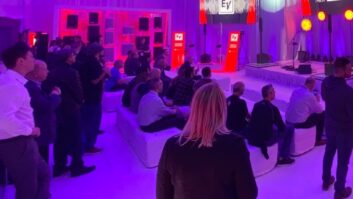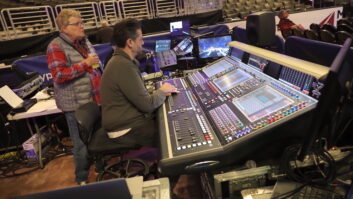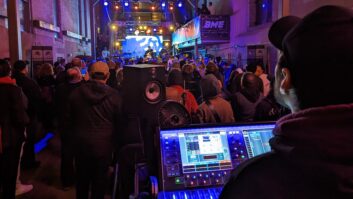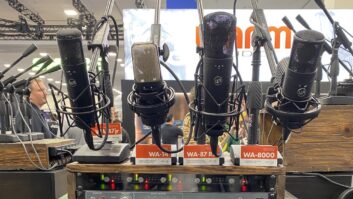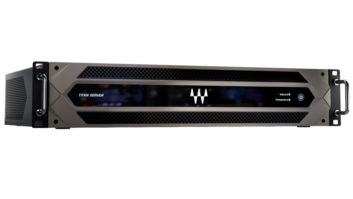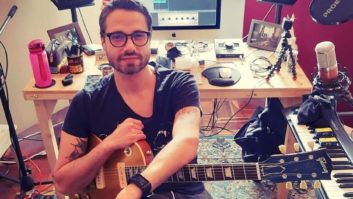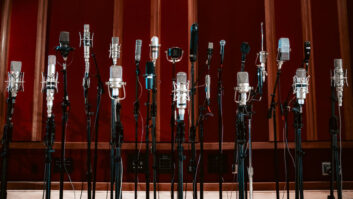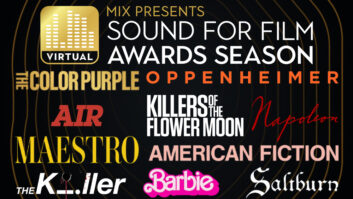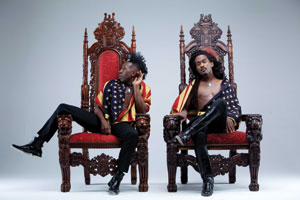
Chuck Lightning and Nate Wonder
What’s in a name? Are the two guys at the other end of my interview phone call Nathaniel Irvin III and Charles Joseph II? Nate “Rocket” Wonder and Chuck Lightning? Deep Cotton? Wonder & Lightning? Control Z? The Wondaland Arts Society?
They turn up under all those names, and no doubt others, in their capacities as producers, songwriters, arrangers, singers, musicians and engineers on some of the most intriguing albums coming out of Atlanta in recent years. They are the driving creative force behind the stylish and mesmerizing R&B/pop singer-songwriter Janelle Monáe, whose three eclectic, very high-concept albums—Metropolis Suite I (The Chase), The ArchAndroid and the fall 2013 release The Electric Lady—are wonderfully adventurous and beautifully produced (if thematically a bit opaque and bizarre). Now, on the heels of that latest Monáe album, comes Runaway Radio, Deep Cotton’s “Fixtape” EP (designed to fix the ills of the planet, they say), and Wonder and Lightning—as we’ll call them—are again blurring musical categories and smashing boundaries with a lively four-song set that brings to mind everything from Sly Stone to Talking Heads to ’60s garage rock to ’90s surf-punk.
At this point, no one should be surprised when Wonder and Lightning describe the title track of their EP as Clash-meets-Funkadelic or note that the groovelicious dance track “We’re Far Enough from Heaven Now We Can Freak Out” was inspired by a 1966 Rolling Stones performance of “Satisfaction” on The Ed Sullivan Show, LSD pioneers Ken Kesey and his Merry Pranksters, and revolutionary Detroit rockers the MC5, among others. These guys are voracious music and culture fans who will employ any style, any time, if it feels right. That’s why on Monáe’s The Electric Lady, there are thumping funk and R&B numbers, orchestral interludes, a ballad that sounds like it could have been pulled off a ’50s pop record, propulsive Stevie Wonder-ish synth lines and even a taste of what is sometimes called “exotica”—’50s/’60s easy listening music with a Latin or some other odd twist.
Where does that last influence come from? “Oh, we love that stuff,” Wonder says. “We listened a whole lot to this one album by a guy named John-Jacque Perrey. Nobody even knows about this guy. [Perrey was an early Moog musician, and also a favorite of the Beastie Boys.] But we’ve always liked that kind of music. We like [Henry] Mancini and stuff that has that vibe—The Pink Panther. And we like orchestral music, too: [film composer] Bernard Hermann…”
Lightning adds, “We want to give people that experience of hearing symphonic music and remind them that this level of music still exists and it’s still very, very important and it can really affect you. It reminds me of later-era Frank Zappa, when he was composing music to be played by orchestras. We want to compose music like that.”

Wonder, Lightning and Monáe are all part of a loose, highly collaborative Atlanta collective (Monáe calls it a “tribe”) known as the Wondaland Arts Society, which includes musicians, producers, visual artists, writers and assorted creative types and intellectuals. It’s quite the salon, headquartered in a large brick building that includes Wondaland Studios and a host of unusual rooms and spaces decorated with everything from grass flooring to a wall of clocks to odd sculptures and art objects. Musicians such as drummer Pete Alexander, guitarist Kellindo Parker and Wonder’s multitalented younger brother, Roman GianArthur (Irvin), aren’t well-known outside of Wondaland productions, but these cats—and the scads of string and horn players and singers who help out on their projects—are all versatile and deeply talented. Monáe’s album also features striking performances by a handful of fellow eclectics—Prince, Erykah Badu, Esperanza Spalding, Solange and Miguel.
The studio itself “has guitars all over the walls and lots of vintage keyboards and other instruments all over the place,” Wonder says. “We love old stuff, even though sometimes you have to send it out to get fixed, or we have to fix it ourselves. We’ve got ARPs and Moogs and Junos and Clavs, Prophets—all these great old instruments we have set up so it’s easy to move from one to the next and try stuff out.”
Wonder and Lightning are constantly experimenting when they record, combining old and new sounds in interesting ways and drawing from myriad inspirations as both producers and musicians. They cite Stevie Wonder as one of their primary influences and note that they have studied his albums and “really tried to understand his process and how he got the sounds he did,” Wonder says. “We’ve also gotten to know Stevie—in fact we worked with him a couple of days ago—so we’ve been able to ask him a million questions about how he did this or that.”
“Of modern producers,” Lightning adds, “Jon Brion [Of Montreal, Best Coast, etc.] is someone we’ve learned a lot from. His understanding of the studio and his ability to bring in vintage sounds is amazing.” Another, perhaps unexpected, influence—Brian Eno.
Both The Electric Lady and Runaway Radio were mixed by Chris Carmouche on an SSL console at Stankonia Studios (OutKast’s Atlanta facility). Says Wonder, “We’ve heard a lot of music over there so we really know what the room sounds like. When it comes to mixing, you want a space you know the nuances of and feel comfortable in. It seems like we’re always recording and mixing, always changing things a little, coming up with new ideas.”
“We’ve actually added things to arrangements at the mastering phase,” Lightning notes. And Wonder adds, “I’d like to release another version of the album next week!”
